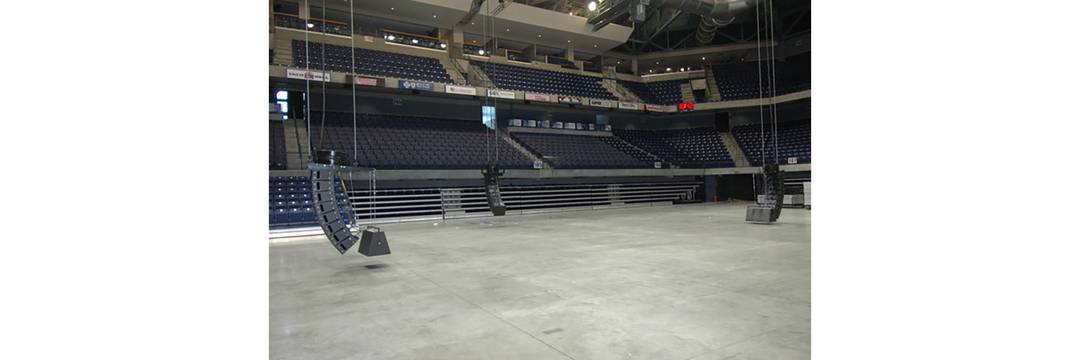
ロードアイランド大学のライアンセンターがQ-SYSでよりスマートなシステムを取得
QSC Audio Does its Homework to Improve Intelligibility and Aesthetics
Kingston, RI (March 23, 2011) -- The Ryan Center, a $54 million, 7,500 seat multi-purpose arena on the grounds of the University of Rhode Island, is home to a variety of events including family entertainment, concerts, sports competitions, conventions and a host of other community affairs. Recently, Ryan graduated to a much more intelligent sound system with the help of QSC Audio.
Growing concerns with the intelligibility and the overall aesthetics of the venue’s P.A. system led the Center to hire respected A/V system consultant, North American Theatrix, to analyze the state of the system. In reviewing the existing installation, NAT determined that a physical re-arrangement of the existing clusters would cost approximately 1/3 of an all-new cluster, not including additional necessary components. However, the manufacturer of that system was not actively supporting this equipment, so replacements would have to be ordered as custom-built product. Not finding this to be an acceptable solution, NAT recommended an all-new system upgrade.
The design and integration of the new QSC system was handled by the NAT team of Gary Peck, Jeff Mele and Keith Book. “The inherent challenge of the venue was that the intelligibility was very poor,” says Mele.
The NAT team recommended the complete system upgrade, integrating QSC Wideline-8 Line Arrays, ADS52T speakers for the concourse zones and a QSC Q-SYS system for redundancy and overall system control. Existing QSC CX Series amplifiers were also integrated into the new system.
The team chose the new system specifically for its wide projection, processing, horsepower, and especially QSC’s reliability factor. “QSC is one of the most reliable manufacturers we work with,” says Mele. “They always do their homework to fill the void by asking questions of the proper sources.”
“There were around 50 very large boxes hanging 60 feet over the gym floor which hung from wire rope and threaded rod, some of which stretched 80 feet to the roof ceiling. We used a 120’ Genie lift to reach these heights and chain motors to drop them. Once the existing boxes were removed, the transition was easy and the new system was completed in about 4 days.” adds Peck. “The result of this change was both improved audio as well as better aesthetics and sightlines.”
In the new system, redundant Q-Sys Cores distribute audio throughout the venue. NAT also utilized Q-Sys as the control engine for the entire Ryan Center. Custom panels, created in the Q-Sys environment, are served by the Cores to PCs or any other networked appliances (iPads, for example), which can also be used for monitoring or making system adjustments.
“We wanted to replace the digital signal processing with a more suitable configuration for the line array program with 100% redundancy for the primary arena speakers, while still satisfying the requirements for secondary evacuation annunciation,” says Book. “This new system has the horsepower to control all the ancillary systems throughout the building.”
With the installation complete, the Ryan Center staff was extremely pleased and the completed system surpassed their expectations. “The Ryan Center now has a number of options for expansion as we are only now using about one-third of the DSP I/O potential,” says Mele. “And the center now has more flexibility in control versus the switches, knobs, and dials installed previously in 2002. Looking ahead, the Ryan Center has the capacity to grow with this system without having to add more processing later.”
Watch the time lapse video of the speaker clusters being replaced on YouTube: (http://www.youtube.com/watch?v=2yEMLE4hbNs).